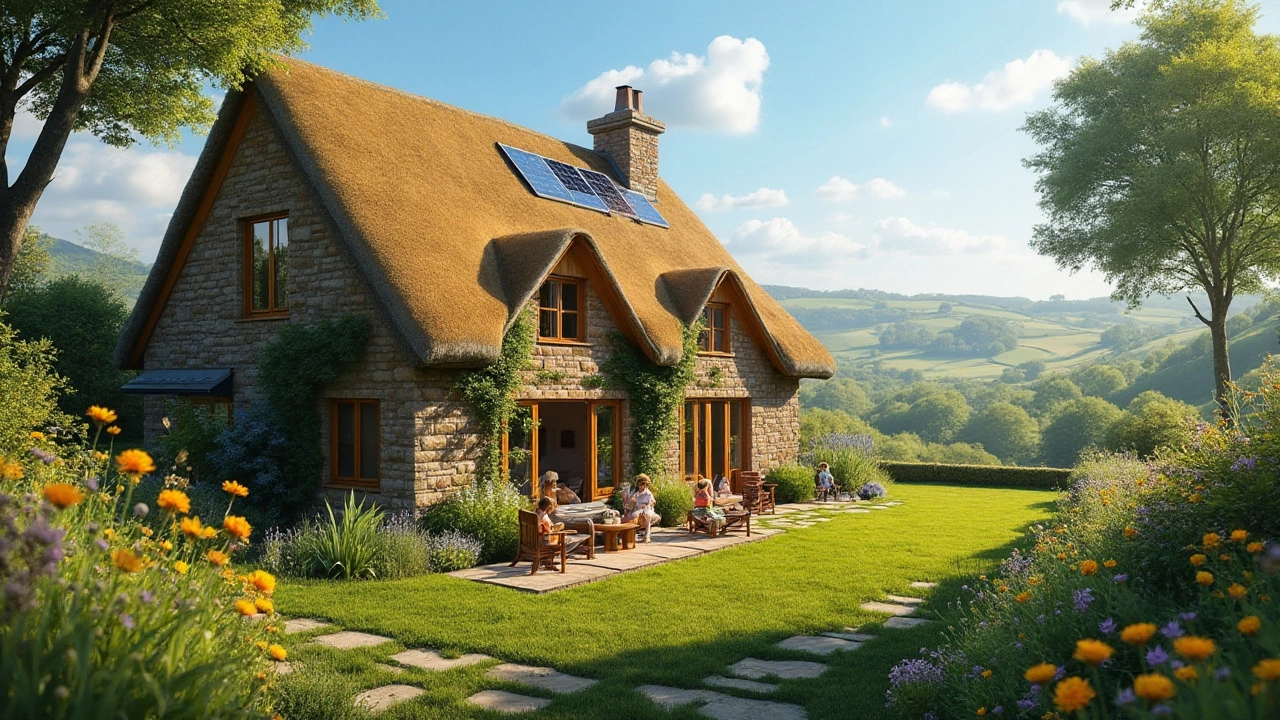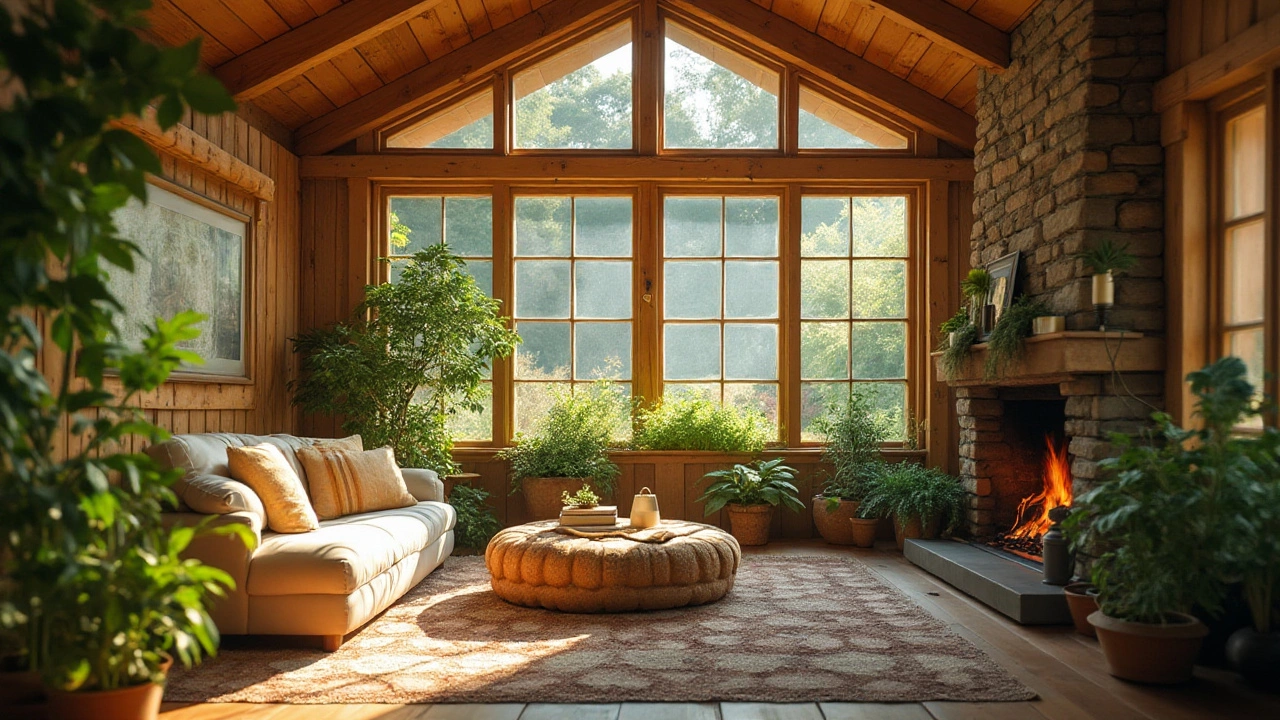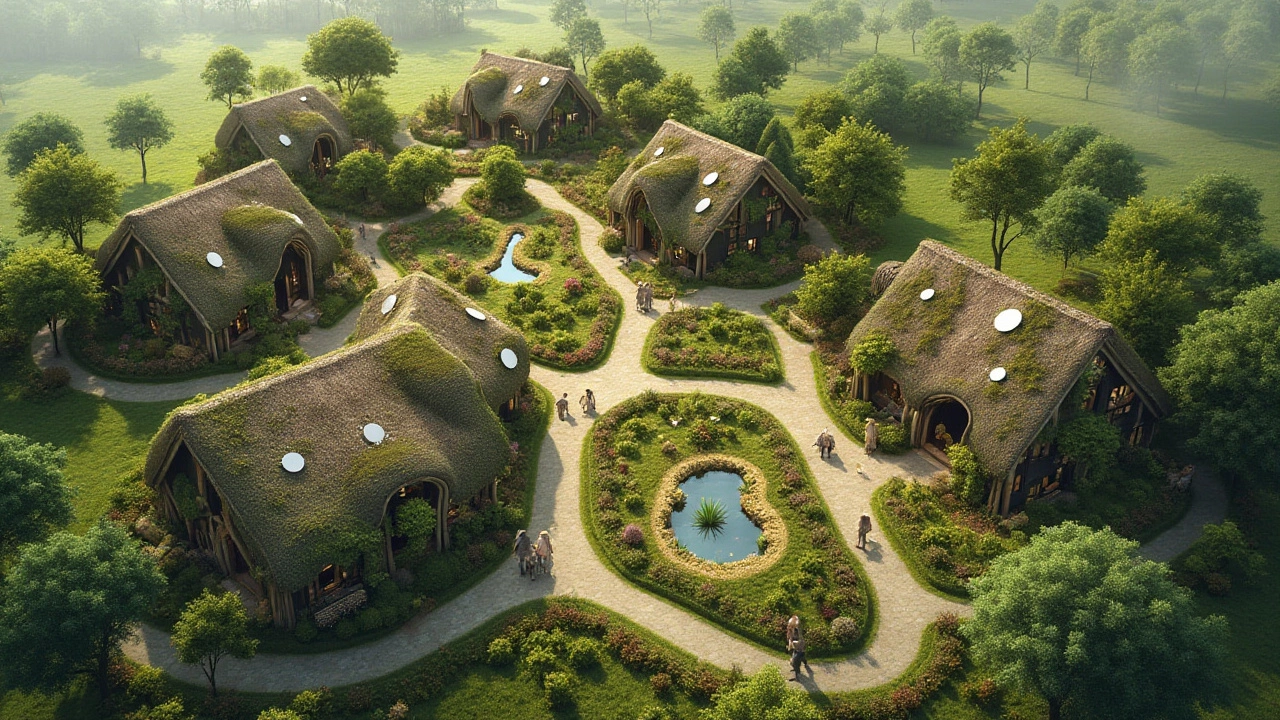Unveiling the Magic of Eco Cottages: A Sustainable Lifestyle
 Oct, 13 2024
Oct, 13 2024
Eco cottages are more than just a trend in green living; they are a commitment to sustainable and harmonious living with nature. These quaint dwellings offer a refuge from the hustle and bustle of modern life while ensuring minimal environmental impact.
Built with sustainable materials and designed for energy efficiency, eco cottages embrace innovative design solutions to reduce carbon footprints. From solar panels to rainwater harvesting systems, every element is thoughtfully chosen to preserve our planet's resources.
Discover what sets eco cottages apart from conventional homes and the joy of living in a space that respects our environment. Whether you're dreaming of building your own or curious about green architectural practices, this journey into eco-friendly living promises insights and inspiration.
- Defining Eco Cottages
- Sustainable Building Materials
- Energy Efficiency and Design
- The Benefits of Eco Cottages
- Tips for Creating Your Own Eco Cottage
Defining Eco Cottages
An eco cottage is not just a place to live; it embodies a lifestyle choice that prioritizes sustainability and environmental consciousness. These homes are designed with a keen focus on reducing environmental impact and encouraging harmony with the natural surroundings. Unlike traditional homes, eco cottages harness innovative design principles and materials that emphasize renewable resources and energy efficiency.
The very essence of an eco cottage lies in its construction materials. Reclaimed wood, bamboo, and straw bales are popular choices, providing not only a unique aesthetic but also reducing the need for new raw materials. Natural insulation materials like sheep's wool or recycled denim keep the cottage warm in winter and cool in summer, eliminating the need for energy-intensive heating and cooling systems.
Energy efficiency is another hallmark of eco-friendly homes. Many eco cottages incorporate solar panels or small wind turbines to generate electricity. These renewable energy sources significantly reduce dependence on fossil fuels. Some cottages even employ geothermal heating systems, which make use of the earth's natural temperature to regulate indoor climates. This innovative use of resources is what sets eco cottages apart from the conventional housing market.
Additionally, water conservation plays a crucial role. Rainwater harvesting systems are common, collecting and storing rainwater for use in gardening and other non-potable applications. Greywater recycling systems further optimize water use by treating and repurposing wastewater for irrigation needs. This thoughtful integration of sustainable practices helps conserve valuable resources and reduce the household's overall ecological footprint.
But the concept of an eco cottage extends beyond tangible elements. Occupants of such cottages often embrace a lifestyle of simplicity and minimalism, focusing on reducing waste and living within their means. They cultivate gardens to grow fresh produce, reducing reliance on supermarket goods. This holistic approach to living encourages deeper connections with the surrounding environment and fosters a sense of responsibility towards nature.
"Eco cottages empower individuals to live more sustainably, providing practical solutions to everyday environmental challenges," said Jane Doe, a renowned environmental architect.
Even within these sustainable confines, comfort is not sacrificed. Through thoughtful design and careful consideration of natural light, cross-ventilation, and spatial arrangements, eco cottages offer warm and inviting living spaces. They often include multi-functional spaces and use layout techniques that optimize space, accommodating both families and individuals seeking a simpler, greener way of life.
As consumer awareness around sustainable living continues to grow, eco cottages represent a beacon of hope. They illustrate how architecture can interlace with nature, addressing the urgency of environmental issues while still offering beauty and functionality. Whether perched on a hillside or nestled in a forest, these cottages stand as testament to the possibilities of living in sync with nature.
Sustainable Building Materials
The foundation of eco cottages lies in the use of sustainable building materials, a key element that distinguishes them from traditional homes. These materials are chosen not merely for their aesthetics, but for their ability to minimize environmental impact from production to usage. A popular choice in this domain is bamboo, renowned for its rapid growth and incredible strength. Unlike conventional hardwood, bamboo regenerates swiftly, providing a renewable resource that aligns perfectly with the ethos of eco-friendly homes.
Reclaimed wood is another star player in the sustainable material arena. By salvaging wood from old buildings or furniture, the need to cut down new trees is reduced, supporting the preservation of forests. This wood often carries a rustic charm, adding a distinct character to any cottage. Besides, the process of reclaiming wood limits waste, serving as a wonderful example of circular economy principles in action. These materials are accompanied by recycled metal, often used for roofing or structural reinforcements, which not only cut down energy consumption but also perform admirably under various weather conditions.
Innovative materials like rammed earth and straw bales are gradually making their mark as well. Rammed earth walls, which involve compacting earth into walls, provide natural insulation, regulating indoor temperatures. Similarly, straw bales deliver excellent insulation capabilities and are surprisingly fire-resistant when properly constructed. The usage of these natural materials not only reduces reliance on synthetic, high-impact alternatives but also enhances the thermal comfort of sustainable living environments.
"The significant way to sustainability in architecture is to promote the materials and methods that challenge conventional construction and enhance ecological balance," says Dr. Lisa Heschong, noted for her research in sustainable architecture.
Additionally, attention is shifting towards green concrete. Incorporating industrial by-products like fly ash, green concrete minimizes waste, reduces carbon emissions, and can be more durable than traditional concrete. When planning an eco cottage, considering such materials can substantially contribute to a project’s sustainability. Not only do they lessen our carbon footprint, but sustainable materials often promote healthier living conditions by employing fewer toxic chemicals and providing better air quality.
A table provides a simple summary of the materials typically used in eco cottages:
| Material | Sustainability Feature |
|---|---|
| Bamboo | Fast-growing, renewable |
| Reclaimed Wood | Reduces deforestation, recycles old materials |
| Straw Bales | Excellent insulation, low environmental impact |
| Rammed Earth | Natural insulation, energy efficient |
| Green Concrete | Lower emissions, uses industrial by-products |
For those aspiring to lead a sustainable lifestyle or invest in green architecture, the selection of building materials plays a pivotal role. Not only do these choices impact the environmental footprint, but they also define the longevity and efficiency of the cottage. With every brick, plank, or beam carefully chosen, an eco cottage stands as a beacon of a better future, demonstrating how thoughtful design and material choices can harmonize living spaces with the natural world.

Energy Efficiency and Design
When we delve into the realm of eco cottages, energy efficiency becomes a cornerstone of sustainable living and thoughtful design. These homes are meticulously crafted to function seamlessly with the environment while reducing energy consumption to a minimum. The magic begins with the orientation of the cottage; strategically positioning the building to take advantage of natural sunlight can profoundly cut down on the need for artificial lighting and heating. Using large windows not only bathes interiors with natural light but also harnesses passive solar heat, keeping your cottage warm even on chilly days. In the summer, overhangs or pergolas become your best ally by shading windows and keeping interiors cool without the burden on air conditioning systems.
But it's not just about placing your windows and walls right; materials play a monumental role in how energy is utilized. Insulation is a key player here, often made from sustainable materials such as sheep's wool or cellulose. These materials go a long way in ensuring that the inside of the cottage remains a haven, retaining warmth in winter while keeping out the summer heat. Pairing these with energy-efficient appliances and LED lighting can make a significant difference in energy use. According to a study conducted by the National Renewable Energy Laboratory, houses that utilize integrated design strategies like these can save up to 40% on energy costs compared to conventional homes.
The U.S. Department of Energy notes, "Energy-efficient home design allows for the principles and mechanisms of energy conservation to be implemented from the very beginning, ensuring sustainable living standards."
Incorporating Renewable Energy
In the pursuit of creating a truly green home, renewable energy sources come into play. Solar panels top the list, converting sunlight into electricity that can power everything from heating systems to essential appliances. Many eco cottages include solar water heaters, which efficiently provide hot water by utilizing the energy of the sun. For areas with consistent wind conditions, small wind turbines might also be a viable supplementary power source, adding another layer of independence from the grid. Energy storage solutions, like the latest lithium-ion batteries, enable the cottage to store excess power generated, ensuring the lights stay on even when the sun isn't shining or the wind isn't blowing.
It's not merely about saving money on energy bills; it's about embracing a lifestyle that cherishes earth's finite resources. Effective design also involves water conservation; rainwater harvesting systems are a great addition. These systems collect rain from rooftops, directing it to storage tanks for irrigation or household use, significantly reducing reliance on municipal water supplies. Among the eco-conscious community, such systems demonstrate practicality and respect for the natural cycle of resources. By integrating these features, an eco cottage stands as more than just a home; it symbolizes a harmonious blend of comfort and conservation, proving that living sustainably does not mean compromising on the quality of life.Sustainable living within an eco cottage isn’t just about basics; it calls upon a clever mix of modern technology and traditional wisdom to create a dwelling where efficiency and design wonderfully coalesce.
The Benefits of Eco Cottages
Choosing to live in an eco cottage is more than a nod to sustainability; it's a lifestyle that harmonizes comfort with environmental stewardship. At the heart of these dwellings lies an appreciation for nature and a genuine effort to preserve it. One of the foremost benefits of an eco cottage is its ability to significantly reduce the carbon footprint. Many of these cottages use renewable energy sources like solar panels or wind turbines, which not only reduce reliance on fossil fuels but also often result in energy bills that are a fraction of those in conventional homes. The integration of these technologies reflects a thoughtful choice towards sustainable living, benefiting both homeowners and the planet.
Beyond energy efficiency, eco-friendly homes crafted with sustainable materials create a healthier living environment. Natural, non-toxic building materials like bamboo, reclaimed wood, and straw bales help avoid the chemical off-gassing common in synthetic materials, ensuring cleaner indoor air quality. Such choices are particularly important for those with allergies or respiratory issues as they can drastically improve overall health and well-being. Moreover, these materials often require less energy to produce and transport, adding an understated but important layer of sustainability to every eco cottage.
Water conservation is another poignant benefit. Many eco cottages incorporate systems to harvest and filter rainwater, reducing dependency on external water sources and minimizing strain on the water table. Efficient plumbing fixtures and greywater recycling systems make the most of this precious resource, illustrating a conscious effort to manage water use wisely. According to a report by the EPA, switching to water-efficient fixtures can reduce water usage by 20%, offering long-term savings both environmentally and financially.
In addition to their practical advantages, these sustainable homes often encourage a deeper connection with the natural world. The designs typically include large windows and living spaces that seamlessly blend indoor and outdoor environments, bringing in ample natural light and stunning vistas. This connection not only boosts mood and well-being but fosters a lifestyle that is more attuned to the rhythms and beauty of the natural world.
"Simplicity is the ultimate sophistication," famously remarked Leonardo da Vinci—a sentiment echoed in the very essence of eco cottages.Owning such a home often catalyzes a holistic shift, inspiring inhabitants to adopt greener habits in aspects of life beyond their home boundaries.
With aesthetics that balance modern comforts and environmental mindfulness, eco cottages are tailor-made for a burgeoning audience eager to make responsible lifestyle choices. Embracing the eco cottage lifestyle means enjoying benefits that extend beyond the basics of shelter. Reduced environmental impact, healthier indoor environments, and the fostering of a sustainable mindset make these homes notable and purpose-driven havens where one can truly coexist with nature.

Tips for Creating Your Own Eco Cottage
Embarking on the journey to create your own eco cottage is both exciting and immensely rewarding. To begin, it's essential to consider the selection of sustainable building materials. Look for locally sourced timber, recycled steel, and eco-friendly insulation options like wool or hemp. These not only reduce transportation emissions but also support local economies. Stone and clay, often overlooked, are also excellent natural materials that offer great thermal mass, keeping your cottage warm in winter and cool in summer.
Energy efficiency stands as the backbone of any eco-friendly home. While solar panels are a popular choice for power generation, they're just the beginning. Explore the potential of wind turbines if your location permits, or perhaps a ground source heat pump to cater to heating needs. Insulation plays a crucial role here, too. A well-insulated eco cottage minimizes energy loss and ultimately reduces your reliance on active heating and cooling systems.
Design is more than aesthetics; it's about function and flow. An open floor plan can allow natural light to flood the interior, reducing the need for artificial lighting. Passive solar design will make the most of the sun’s path, capturing heat in winter and offering shade in summer. Skylights or clerestory windows are wonderful additions for maximizing daylight while maintaining privacy. Consider rainwater harvesting systems for irrigation or non-potable uses, turning rainy days into resourceful opportunities.
No eco cottage should overlook its surroundings. Landscaping with native plants can enhance biodiversity and require less watering and maintenance. Create spaces that encourage outdoor living – think garden paths made from reclaimed materials, or perhaps a pergola covered with climbing plants. Choose paint with low or no volatile organic compounds (VOCs) to ensure the air quality remains as fresh as the surrounding fields.
To personalize and bring character into your eco-friendly home, think about incorporating reclaimed furniture or bamboo flooring. Each choice adds a story, enriching the tapestry of your sustainable dwelling. Craft spaces that resonate with your needs while keeping Mother Nature in mind.
"Building an eco cottage is not just about living green, it's about redefining your connection to the environment," says renowned eco-architect Sarah Susanka.With these thoughtful decisions, you're not just constructing a house, but creating a sanctuary that honors and protects the planet.